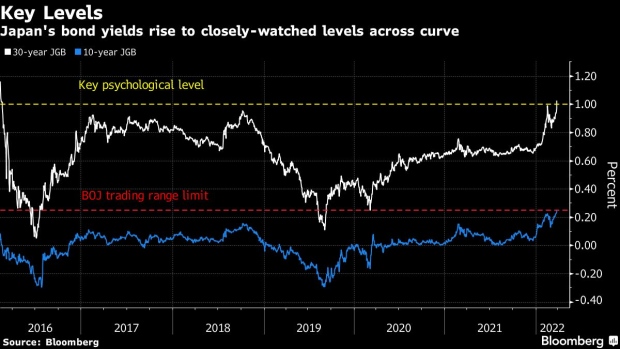Mar 28, 2022
Tokyo Traders Ready for Another Day of BOJ Intervention
, Bloomberg News

(Bloomberg) -- Japan bond and currency traders are braced for further volatility Tuesday with the central bank set to continue with its unprecedented intervention in a bid to cap a surge in yields.
Bonds are expected to remain under pressure even after the Bank of Japan pledged to buy an unlimited amount of benchmark notes over the next three days. While a retreat in Treasury yields overnight may bring a short-term respite, longer-dated Japanese bonds outside the BOJ’s control are seen as vulnerable, especially if there is further volatility in global markets.
BOJ Steps Into Market to Cap Yields Amid Global Bond Selloff
“From March 29-31, they know the BOJ is available to buy bonds at least once a day, but it’s not that the central bank is available 24 hours a day, so there will still be selling pressure from those who need to unwind when they want to,” said Naomi Muguruma, a senior market economist at Mitsubishi UFJ Morgan Stanley Securities Co. in Tokyo. “The 10-year yield could top 0.25% if such selling intensifies between BOJ operations.”
Japan’s central bank intervened in the market in an extraordinary manner Monday after a slump in global bonds pushed benchmark yields to the upper end of its 0.25% tolerated limit. It conducted two unlimited purchase operations Monday -- and announced plans for more through Thursday -- a move which sent the yen plummeting to a seven-year low.
Yen Tumbles to Seven-Year Low as BOJ Diverges Further From Fed
The intervention underscored the central bank’s commitment to keep monetary settings loose, following Governor Haruhiko Kuroda’s earlier remarks that policy will remain unchanged even if inflation jumps. But it failed to push yields lower -- the 10-year closed at 0.25% Monday.
“We believe that the BOJ’s operation desk is not authorized to let the 10-year JGB yield rise above 25 basis points,” said Citigroup’s Tomohisa Fujiki in a note to clients. “Any policy changes will be decided at monetary policy meetings, so the 25 basis point cap should be in place at least until the next meeting on April 28.”
While the 10-year benchmark is capped, the BOJ has let super-long yields rise, saying too low levels in these sectors would be negative for investors and the economy. The 30-year yield touched 1% Monday for the first time in six years.
The central bank is unlikely to conduct fixed rate operations in other sectors as it would send too strong a signal on yield levels the BOJ isn’t controlling, said Citi’s Fujiki . That means if the Japanese yield curve diverges from fair value, volatility could increase when the BOJ actually exits from the current framework, he added.
“We are probably starting to see the limit of the yield curve control program,” said Takahiro Sekido, chief Japan strategist at MUFG Bank and a former BOJ official. The ‘slew’ of actions “suggests that the yield curve control can’t be carried on as it is now. They may have to make it more flexible or may need to tweak it.”
The BOJ action spilled into the currency market sending the yen to a seven-year low and sparking chatter of further intervention, this time from the government. Japan is caught between a dovish BOJ and hawkish Federal Reserve which has widened the yield gap between the two countries and pushed down the yen.
“The FX market is pricing increased policy divergence between Japan and the rest of the world, but the rates market is starting to doubt how long this can last,” said George Saravelos, Deutsche Bank’s global head of currency research in London. “Either Japan will finally ‘make it’ out of deflation by tolerating a more sustained currency overshoot, or the BOJ will have to ‘break it’ and abandon yield curve control just like the RBA did last year.”
(Adds comment in ninth paragraph.)
©2022 Bloomberg L.P.





